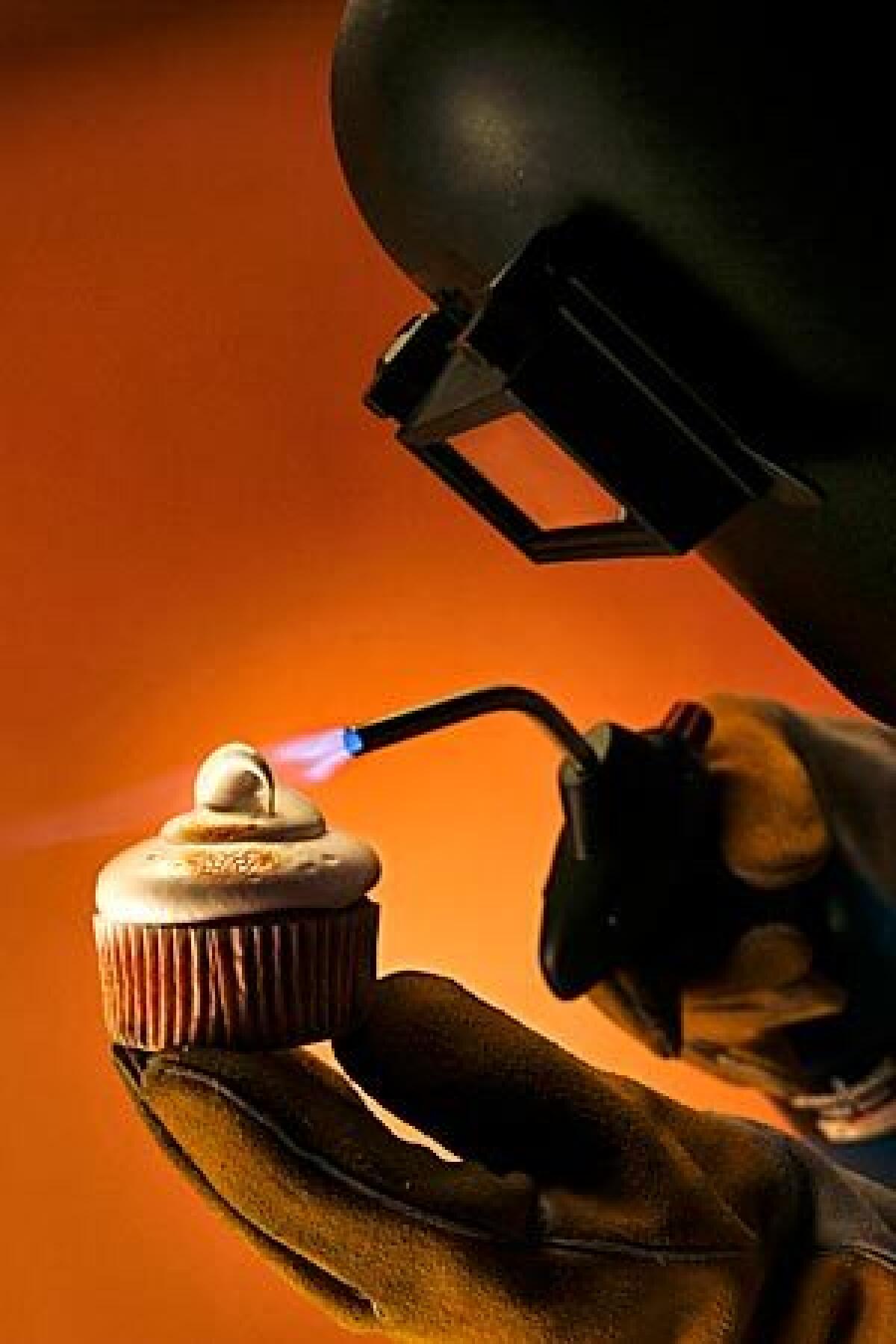Ready, aim, fire that crème brûlée

- Share via
One of the most appealing things about open kitchens — and the trend of letting the rest of us see into the inner machinery, the smoke and clash and vaguely militaristic operation of a restaurant — is the occasional flare and whoosh of fire. We are, most of us, secret pyromaniacs.
Watching a chef flambé something (a crepe, steak Diane, an apron) maintains the willing suspension of disbelief that professional cooking is, after all, a beautiful and possibly dangerous high-wire circus act and not just dinner.
But you don’t have to be a professional chef to set things on fire, deliberately. Home cooks can light a match to a sauté pan or fire up a blowtorch to burn a layer of sugar across a crème brûlée as well as anybody. With a few simple precautions (cookbooks really should read like Scout manuals) and the right tools, you can have just as much fun playing with fire as Antonin Carême did lighting it up with his French kitchen brigade.
Along with a gas stove and a box of wooden matches, the best and definitely the most satisfying kitchen gear any closet kitchen pyro needs is a blowtorch. A real blowtorch, like one you’d imagine Robert Downey Jr. would use in his kitchen.
Think you’ve got a winning burger recipe? Submit it to the L.A. Times’ first Battle of the Burgers.
Don’t bother with the adorable things you find at boutique cooking stores. Sure, they work, sort of, but they’re expensive, disappointingly small and downright prissy compared with what you find at a hardware store. They’re fine for tea parties with dainty toasted meringues, but the smaller butane lighters simply don’t have the raw power or the dramatic flourish of the propane welder’s torches.
Besides, if you want to get men — and teenagers and most preteens, if you think about it — interested in cooking, there are few better ways of doing this than a trip to Home Depot. Hardware stores aren’t gender or age specific, anyway. I’ve yet to meet anyone who doesn’t love shopping for kitchen gear amid power tools.
Besides fixing the occasional leaky pipe, a blowtorch can be used for many things in the kitchen. There is crème brûlée, of course, which you have to make simply on principle — and because it’s one of those retro desserts that everyone secretly loves. There are also few better dinner theater moments than the one when you fire up the postprandial torch to caramelize a glowing pool of sugar across the top of a ramekin.
After the de rigueur tray of crème brûlée, blowtorches are terrific for toasting both marshmallows and marshmallow frosting. Think of the s’more as a controlled experiment rather than tiny haphazard sugar explosions around a campfire. Use a blowtorch to put the right amount of color on the top and sides of a meringue pie or a baked Alaska. Or use it to fire a trail of caramelized sugar across a bowl of berries and cream, the melting sugar forming rivulets that later crack like discovered deposits of candy.
Not only is a torch inherently a lot more fun than a broiler, but you also get considerably more control since you can move it around and pull it back if the sugar starts burning. It’s also portable, so you can take your traveling circus on the road. Firing up a blowtorch for the dessert portion of an evening barbecue party is like a legal version of lighting firecrackers in your backyard.
Chefs, of course, have all kinds of party tricks they accomplish with torches.
Pastry chefs use them for brûlées and meringues, but also to unmold terrines and heat the bottoms of metal bowls of buttercream frosting to keep them from breaking. At different stations in a kitchen, cooks might roast chiles or whole peppers, sear tomatoes or add some color to a component of a dish (a scallop, a gratin) already on a plate instead of putting the whole thing under a salamander or broiler.
Sushi chefs are fond of using torches to briefly sear a piece of fish or meat that they do not wish to actually cook. Thomas Keller famously uses his blowtorch to caramelize the surface of a rib roast before putting it in the oven. At Spago in Beverly Hills, cooks have been known to steal longtime pastry chef Sherry Yard’s blowtorch to light the pizza ovens.
One can only imagine all the many things “Modernist Cuisine” author Nathan Myhrvold does behind closed scientific doors with his blowtorch.
Although it may seem utilitarian, a blowtorch is actually a zippy modern improvement on the more atavistic tools French chefs once used to caramelize sugar. Decades past, chefs used a brûlée iron, called a fer à brûler or fer à caraméliser, to melt sugar across custards. A medieval-looking device that resembles a cattle-branding tool more than anything you’d normally find in the kitchen, the iron would be heated in the fire and then lowered just above the sugar-covered custard. Josiah Citrin, chef-owner of Mélisse in Santa Monica, has fond Gallic memories of using the contraptions. Chef Mark Peel says he still has one lurking somewhere in the recesses of his Hollywood restaurant Campanile.
But the problem with both Gothic branding tools and the more pedestrian broilers we have in our ordinary kitchens is that they provide only horizontal uniform heat. Nice for flat surfaces but not so useful for the artful curves and precipitous whorls of a meringue pie, the vertical sides of a baked Alaska or the upward flourishes of a s’mores cupcake crowned with marshmallow frosting.
A blowtorch requires a little dexterity at first, since you don’t want to incinerate your cupcakes or your kitchen, so practice outside, perhaps by lighting your barbecue or even some candles.
You don’t want the fire too close to the food, not only because you want to control the amount of heat but also because you don’t want the propane taste in your meringue. Light the fire first away from anything edible, then regulate the flame and keep it far enough away from the surface area in question, maybe 6 or so inches, depending on your torch.
As for what kind of torch to get, that’s up to you and the contents of your hardware store. My favorite is the BernzOmatic, which is cheap, easy to find and has a name that’s just fun to say out loud. The most basic of these costs less than $20 but requires that you light it with a spark lighter, so maybe shell out about $10 more and get one with a trigger starter. The cans of propane will run you all of $3, and unless you’re planning on opening a pop-up crème brûlée business, they’ll last for a good year or two.
After you get the feel of the flame, crème brûlée becomes a simple party trick, while an enormous prime rib is basic operating procedure. Just remember that you’re still in a kitchen, so leave the plumbing to the experts, and try not to think too much about those early scenes in “Iron Man.” Sometimes a cupcake is just a cupcake.
More to Read
Eat your way across L.A.
Get our weekly Tasting Notes newsletter for reviews, news and more.
You may occasionally receive promotional content from the Los Angeles Times.









